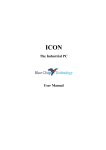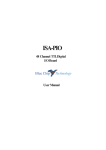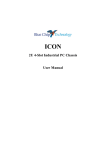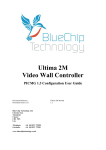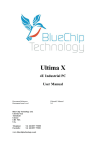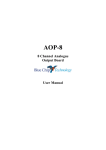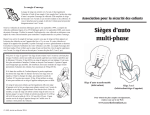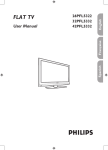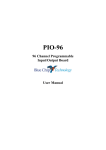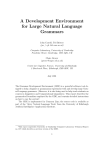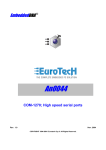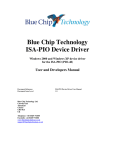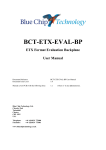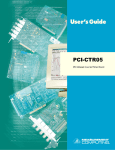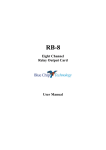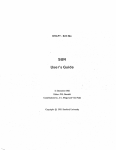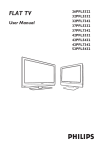Download DPC 10 Data Acquisition Card User Manual
Transcript
DPC-10 10 Channel TTL Digital Counter/Timer Board User Manual DPC-10 User Manual Document Part N° Document Reference Document Issue Level 0127-0201 DPC-10\..\0127-0201.Doc 1.0 Manual covers PCBs identified DPC-10 Rev A All rights reserved. No part of this publication may be reproduced, stored in any retrieval system, or transmitted, in any form or by any means, electronic, mechanical, photocopied, recorded or otherwise, without the prior permission, in writing, from the publisher. For permission in the UK contact Blue Chip Technology. Information offered in this manual is correct at the time of printing. Blue Chip Technology accepts no responsibility for any inaccuracies. This information is subject to change without notice. All trademarks and registered names acknowledged. Blue Chip Technology Ltd. Chowley Oak, Tattenhall Chester, Cheshire CH3 9EX. Telephone : 01829 772000 Facsimile : 01829 772001. Website: http://www.bluechiptechnology.co.uk Amendment History Issue Level 0.7 0.8 1.0 Issue Date 05.05.89 18.07.97 27/03/01 Author L.P SEJ S ORR Amendment Details First draft Window front cover and logo LOGO Updated, Diagrams added Contents 1.0 OUTLINE DESCRIPTION...............................................................2 Electromagnetic Compatibility (EMC)................................................3 EMC Specification .............................................................................4 2.0 SPECIFICATION ............................................................................5 2.1 Electrical Specification................................................................5 2.2 Physical Specification ...............................................................5 3.0 User Adjustments ...........................................................................6 3.1 Selecting the Base Address .......................................................6 3.2 Port Map .....................................................................................6 4.0 Electrical Options ............................................................................7 4.1 Input/Output Connections...........................................................7 4.2 Pin Connection Details ...............................................................7 4.3 Frequency Source Input .............................................................8 4.4 On-board Frequency Selection...................................................9 4.5 Interrupts ....................................................................................9 4.6 Opto-isolation ...........................................................................10 5.0 Operating Guide............................................................................11 5.1 Software Interface ....................................................................11 5.2 Programming Guide .................................................................11 5.3 Example Program.....................................................................11 Blue Chip Technology Ltd. dpc-10.doc Page 1 Outline Description 1.0 OUTLINE DESCRIPTION The DPC-10 board provides two five channel counter-timer devices. Each channel has 16 bit capability and can be used as an event timer, a counter or a frequency generator. Channels can be cascaded to give higher resolution. These devices are particularly powerful and the data sheet should be consulted for the full range of function available. Blue Chip Technology Ltd. dpc-10.doc Page 2 Electromagnetic Compatibility Electromagnetic Compatibility (EMC) This product meets the requirements of the European EMC Directive (89/336/EEC) and is eligible to bear the CE mark. It has been assessed operating in a Blue Chip Technology Icon industrial PC. However, because the board can be installed in a variety of computers, certain conditions have to be applied to ensure that the compatibility is maintained. It meets the requirements for an industrial environment ( Class A product) subject to those conditions. · The board must be installed in a computer system which provides screening suitable for the industrial environment. · Any recommendations made by the computer system manufacturer/supplier must be complied with regarding earthing and the installation of boards. · The board must be installed with the backplate securely screwed to the chassis of the computer to ensure good metal-to-metal (i.e. earth) contact. · Most EMC problems are caused by the external cabling to the board. Boards fitted with IDC ribbon cable connectors on the metal mounting bracket require particularly careful installation of the external cabling. The cabling must be totally screened; the type of ribbon cable which is rolled to a round form with a braided wire screen is best. Standard ribbon cable will not be adquate unless it is contained wholly within the cabinetry housing the industrial PC. The mounting bracket of the board includes a captive nut as a screen earth point. Connect the screen of the cable to this by the shortest possible wire. Blue Chip Technology Ltd. dpc-10.doc Page 3 Electromagnetic Compatibility · Ensure that the screen of the external cable is bonded to a good RF earth at the remote end of the cable. · Cables which connect externally to boards at TTL levels should not exceed to two metres in length. This restriction does not apply to opto-isolated boards. Failure to observe these recommendations may invalidate the EMC compliance. Warning This is a Class A product. In a domestic environment this product may cause radio interference in which case the user may be required to take adequate measures. EMC Specification A Blue Chip Technology Icon industrial PC fitted with this card meets the following specification: Emissions: EN 55022:1995 Radiated Conducted Immunity: Class A Class A & B EN 50082-2:1995 incorporating Electrostatic Discharge IEC 801-2:1984 Performance Criteria B Radio Frequency Susceptibility IEC 801-3:1984 Performance Criteria A Fast Burst Transients IEC 801-4:1988 Performance Criteria B Blue Chip Technology Ltd. dpc-10.doc Page 4 Specification 2.0 SPECIFICATION 2.1 Electrical Specification Number of channels I/O Logic levels 'ON' I/O Logic levels 'OFF' Maximum I/O voltage Maximum count frequency Minimum input pulse width Interrupts Opto-isolation On-board clock source Bus clock source Power requirement Power dissipation 2.2 10 2.4V to 5.5V TTL level 0.0V - 0.8V 5V 7MHz 70nSec IRQ 2-7 (Selectable) Optional (2 channels) 4, 2, 1, .5MHz Link selectable 5V DC, 150mA 500mW Physical Specification Height Width Depth Blue Chip Technology Ltd. 107mm 15mm 132mm dpc-10.doc Page 5 User Adjustments 3.0 USER ADJUSTMENTS 3.1 Selecting the Base Address The board may be located in any 62 pin slot in the PC motherboard but must be set up to appear at a specified position (or ‘address’) in the port map. Available positions are shown in the IBM-PC Technical Reference Guide. However, for those who do not possess a copy of this document, a good place is the location normally allocated to the prototyping card as supplied by IBM. This address is 300 Hex or 768 Decimal. All Blue Chip Technology cards are preset to this address at the factory. However, no two devices should be used while set to the same address since contention will occur and neither board will work. If your machine contains a card with a conflicting address then another reasonably safe address is 200 to 21F (Hex). A set of links is provided on the board to set the base address of the board within the IBM-PC port map. The address is in binary with the presence of a link representing a 0 and the absence of a link representing a 1. To set the base address to 768 Decimal (300 Hex), set the following pattern on the links as indicated.:Figure 1 - Selecting the Base Address Note: View board with back panel on RHS. Middle 8 bit of port address on links. MSB LSB 4 8 10 20 40 80 100 200 More example addresses are shown in Appendix A. Note: No two cards must ocupy the same address. 3.2 Port Map The DPC-10 card has two 9513 counter/timer chips. Each chip has 5 counter inputs and may be programmed to perform a wide variety of functions. These functions are programmed via an address and data port for each 9513. The board occupies four read/write addresses (two for each chip) in the IBM-PC port map. Address Base + 0 Base + 1 Base + 2 Base + 3 Blue Chip Technology Ltd. IC 4 4 5 5 Read Data N/A Data N/A dpc-10.doc Write Data Command Data Command Page 6 Electrical Options 4.0 ELECTRICAL OPTIONS 4.1 Input/Output Connections A 50 way insulation displacement connector (IDC) is provided on the PC rear panel of the board for I/O channel signal connection. If access to individual channels is required, a 50 way IDC ribbon cable may be used to connect the I/O channels to a 50 way terminal block available from Blue Chip Technology as Part Number ST-24. The pins are numbered as shown in the following diagram. Pins 1-48 contain the I/O channels and pins 49 and 50 are connected to digital ground. When the connector is view from the back of the system odd numbered pins are on the left and even numbered pins are on the right with pin 1 a t the top of the connector. 4.2 Pin Connection Details Function IC6 Source 1 Source 2 Source 3 Source 4 Source 5 Pin O O O O O O 2 O 4 O 6 O 8 O 10 Function IC5 Source 1 Source2 Source 3 Source 4 Source 5 Gate 1 Gate 2 Gate 3 Gate 4 Gate 5 Gate 1A Gate 2A Gate 3A Gate 4A Gate 5A 11 O 13 O 15 O 17 O 19 O 21 O 23 O 25 O 27 O 29 O O 12 O 14 O 16 O 18 O 20 O 22 O 24 O 26 O 28 O 30 Gate 1 Gate 2 Gate 3 Gate 4 Gate 5 Gate 1A Gate 2A Gate 3A Gate 4A Gate 5A Out 1 Out 2 Out 3 Out 4 Out 5 Fout Opt 1 +ve Opt 2 +ve +5V 31 O 33 O 35 O 37 O 39 O 41 O 43 O 45 O 47 O O 32 O 34 O 36 O 38 O 40 O 42 O 44 O 46 O 48 Out 1 Out 2 Out 3 Out 4 Out 5 Fout Opt 1 -ve Opt 2 -ve +5V Digital ground 49 O O 50 Digital ground 1 3 5 7 9 Pin Connector Pin View View with gold edge connectors downwards. Note: 100mA Max from pins 47+48. Blue Chip Technology Ltd. dpc-10.doc Page 7 Electrical Options 4.3 Frequency Source Input Two possible sources of frequency input are available on the DPC, from the PC bus or from an on-board oscillator. These inputs may be used for interrupt generation, event timing and many other functions. They are fed into the clock input on IC's 5 and 6. The frequency source is selected for IC5 and IC6 using LKB and LKC respectively, as shown below. For IC5 LKB LKB Bus Frequency Source (B20 on PC Bus) On-Board Frequency Source For IC6 LKC LKC On-Board Frequency Source Bus Frequency Source (B20 on PC Bus) Note that the bus frequency source should be 4.77MHz on all true PC compatibles. Some PC's do not conform to the IBM specification and the bus frequency may be 8MHz or higher. Since this is non-standard the DPC-10 and other cards may not operate correctly in such machines. Blue Chip Technology Ltd. dpc-10.doc Page 8 Electrical Options 4.4 On-board Frequency Selection An on-board oscillator (XL1) is provided to give known frequencyes for use by the 9513 chips. These are linked to the clock input on IC5 and IC6 using CLKA and CKLB. For IC5 CLKB 4 2 1 0.5 2 1 0.5 This shows a 2MHz input selected for IC5 For IC6 CLKA 4 This shows a 0.5MHz input selected for IC6 Note that only one link on JP1 and one on JP2 can be fitted at any one time. 4.5 Interrupts On IC6 it has been arranged that OUT 1 and OUT 2 channels can be linked to selected interrupt lines. OUT 1 from IC6 can be linked to IRQ2, 3 or 4 OUT 2 from IC6 can be linked toIRQ 5, 6 or 7, as shown below: IRQ 2 3 4 IC6 Out 1 5 6 7 IC6 Out 2 The diagram shows: OUT 1 from IC6 linked to IRQ 3 OUT 2 from IC6 linked to IRW 7 Blue Chip Technology Ltd. dpc-10.doc Page 9 Electrical Options 4.6 Opto-isolation An option is available to opto-isolate2 inputs. These inputs are connected via pins 43+44 and 45+46 on the IDC connector. (See 4.2) In order to utilise this facility the user must fir two chips: IC8 = 74LS14, IC9 = ILCT-6. The current must be limited (by fitting external resistors) to s auitable level for the opto-isoltors. The value of this resistor must be calculated to ensure that the current passing through thr opto-isolator is limited to 10mA. The opto-isolator will drop 1.5V constantly. REQUIRED RESISTANCE = (INPUT VOLTAGE - 1.5V) 0.01 The following table gives some common examples using preferred resisitor values: Input Voltage 5V 10V 12V 24V Resistor 330R 820R 1K 2K2 The resultant isolated signals appear as OPT 1 and OPT 2 on the board. OPT 1 (Pins 43+44) OPT 2 (Pins 45+46) Blue Chip Technology Ltd. dpc-10.doc Page 10 Operating Guide 5.0 OPERATING GUIDE 5.1 Software Interface The AMD9513 Counter/Timer/Pulse generator chip is a very powerful and complex device. To assist the user in his or her efforts to design software for the DPC-10, we have included a reasonably comprehensive datasheet for the device itself is included in this manual with a copy of the circuit diagram of the board. 5.2 Programming Guide The AMD9513 chip ports may be accessed using either of the following methods:INPUT (a) Microsoft BASICA or GW BASIC X=INP (P) Returns the byte from port P and assigns this value to the variable, X. (b) 8088/8086 Assembly language PORT EQU GETDAT: 0300H MOV DX,PORT IN AL,DX RET OUTPUT (a) Microsoft BASICA or GW BASIC OUT P,D Outputs the byte D to port P (b) 8088/8086 Assembly language PORT EQU PUTDAT: 0300H MOV DX,PORT MOV AX,DATA OUT DX,AL RET 5.3 Example Program The following program in Microsoft BASIC will test the operation of the DPC-10. No connections to the board are necessary to run this program. 10 20 30 40 50 60 70 80 82 90 100 REM DPC-10 TEST PROGRAM DBJDPC.BAS REM BY D. JOHNSON VERS 1.0 01/05/87 REM counter 1 decrements at 400Hz its load register is set at 400 REM this 1 second terminal count is counted by counter 2 & displayed CLS LOCATE 1,10 PRINT “BLUE CHIP TECHNOLOGY DPC-10 TEST PROGRAM VERS 1.0” LOCATE 5,20:PRINT “ENTER BASE ADDRESS OF DPC-10 :”; INPUT BASE LOCATE 5,20:PRINT “ COUNT = seconds OUT BASE+1, &H17 Blue Chip Technology Ltd. dpc-10.doc Page 11 Operating Guide 110 120 130 140 150 160 170 180 182 184 186 187 188 189 190 200 210 220 230 245 250 255 260 OUT BASE, 0 OUT BASE, &HC0 OUT BASE+1,&H1 OUT BASE, &H32 OUT BASE, &HF ‘Count F5 down in BCD OUT BASE+1, &H9 OUT BASE, &H0 OUT BASE, &H4 ‘Decrement 400 at 400Hz to give1 sec output OUT BASE+1, &H2 OUT BASE, 28 OUT BASE, 0 ‘Counts up the output from counter 1 OUT BASE+1, &HA OUT BASE, 0 OUT BASE, 0 ‘Counter 2 cleared at start OUT BASE+1, &H63 ‘Load and Arm both counters OUT BASE+1, &HA2 ‘Save current value in counter OUT BASE+1, &H12 ‘Read it and convert from BCD LSB=INP (BASE) MSB=INP (BASE) MD=(MSB AND &HF) +10* (MSB AND &HF0) *2Ù-4 LD=(LSB AND &HF) +10* (LSB and &HF0) *2Ù-4 LOCATE 5, 38:PRINT MD*100+LD GOTO 200 ‘Repeat. End with BREAK The above program runs continuously and can only be stopped by pressing Control and Break simultaneously on the PC keyboard. Whilst every effort has been taken to ensure that the information provided is accurate, Blue Chip Technology cannot assume responsibility for any errors in this manual or their consequences. Should any errors be detected, the company would greatly appreciate being inofrmed of them. A policy of continuos product development is operated, resulting in the contents of this document being subject to change without notice. Blue Chip Technology Ltd. dpc-10.doc Page 12















